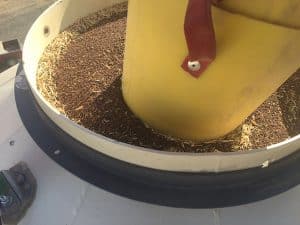We recommend growers put canola on aeration as soon as it comes off the field. Cooling hot grain within the first 24 hours is important for safe long-term storage. This also removes moisture that sweats from all canola. Conditioning achieves both of these steps.
Here are a few handy tips
Stop conditioning when raining
Don’t run the fan in the rain and when relative humidity (RH) is 100%. As a general rule, turn the fan on if (a) it is not raining and the RH is less than 80% and (b) air temperature is less than the canola temperature.
Cooling is critical
Hot canola is a storage risk. If cooling is the primary goal, turn off the fans on hot days. On cool days, take a load or two out of bins and leave them on trucks overnight. This will help cool the bin and the turning activity of removing the central core of grain can help reduce spoilage risk.
Natural air drying and temperature
Temperature is a big factor in natural air’s drying power. The key is actually the temperature difference between the canola and the outside air. As long as the outside air temp is lower than your canola, then drying will occur. Cool air and warm grain can provide decent drying results. PAMI provides these four quick reminders on the relationship between air temperature, grain temperature and drying:
- Warm air and warm grain = drying
- Warm air and cool grain = wetting
- Cool air and warm grain = quick (short term) drying
- Cool air and cold grain = some wetting
Very little moisture movement or removal occurs when the air and grain temperature drop below approximately 5°C. So if the canola goes into the bin at 15°C and tough (let’s say 12%), cooling it to 5°C will certainly pull out some moisture, but may only take it to 11%. Heated air drying may be required.
Dry damp canola
Very tough or damp canola will have increased storage risk and probably should be dried with heated air. Storing tough canola very cold can reduce the risk, but the risk is still higher than it would be for canola stored at 8% moisture.
Airflow is key
Airflow rate is key for aeration and natural air drying of canola. A bin of canola generates a high static pressure (or resistance to airflow) which results in a lower airflow rate from the fan. For temperature conditioning, you need 0.1 to 0.2 cfm/bu. To efficiently remove moisture from the seed you need 0.75 to 1.5 cfm/bu. The old rule of thumb to have 1 hp of fan power per 1,000 bu is misleading, particularly for the larger bins that are more common today.
Canola in large bins
Larger bins filled over a few days due to intermittent harvesting in less than ideal conditions will have areas of various moisture levels and temperatures. Don’t wait until the bin is full to turn on the fans. Drying in large bins
Keep it clean
Always remember to Keep It Clean by avoiding the use of malathion prior to storing canola.


